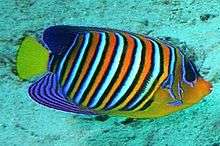Royal angelfish
The regal angelfish (Pygoplites diacanthus) or royal angelfish, is a species of marine angelfish of the family Pomacanthidae, and the monotypic genus Pygoplites. It is found in tropical Indo-Pacific oceans. It can grow as long as 25 cm.
| Royal angelfish | |
|---|---|
 | |
| Scientific classification | |
| Kingdom: | Animalia |
| Phylum: | Chordata |
| Class: | Actinopterygii |
| Order: | Perciformes |
| Family: | Pomacanthidae |
| Genus: | Pygoplites Fraser-Brunner, 1933 |
| Species: | P. diacanthus |
| Binomial name | |
| Pygoplites diacanthus (Boddaert, 1772) | |
Description
The body of the Regal Angelfish is moderately elongate and is very compressed. The preorbital bone convex and has no strong spines. There is 1 prominent spine at an angle at the preopercal. The ventral edge of the interopercle is smooth. The eyes are moderately small along with the mouth that is terminal. The mouth is also protractile.[1] They have a maximum length of 25.0 cm.[2] They have a total of 14 dorsal spines, and 17-19 soft dorsal rays. They have 3 anal spines and 17-19 anal soft rays. They also have 16-17 pectoral fin rays.[3] Their caudal fin is rounded. The precise coloration of this fish can vary as regional differences can occur, most notably in populations from the Indian Ocean, Red Sea, and South Pacific Ocean. A commonality, however, is a body edged in narrow blue-white and orange stripes that are narrow and angle backward. The posterior portion of dorsal fin is black or blue with close-set blue dots, and the posterior portion of anal fin has alternating yellow and blue bands running parallel to body contour. The caudal fin is yellow. Juveniles are colored with a large dark spot on basal portion of the soft dorsal fin.[1] They have been reported of living 15 years.[2]
Recent research indicates that the Pygoplites comprises two morphs, with the variants potentially hybridizing at Christmas Island.[3]
 (Indian Ocean)
(Indian Ocean) (Red Sea)
(Red Sea) (Indo-Pacific)
(Indo-Pacific)
Distribution
The Regal Angelfish is widely distributed throughout the Indo-Pacific.[3] The species can be found in the Red Sea and Indian Ocean around East Africa and the Maldives, stretching to the Tuamoto Islands, New Caledonia, and Great Barrier Reef.[2] The northernmost limits of its range ends in the southern East China Sea around Taiwan and the Ryukyu Islands and Ogasawara Islands of Japan.[2]
Ecology
Pygoplites diacanthus occurs at depths ranging from 0 to 80m, in coral rich areas of lagoons, reefs, and are also often found in the vicinity of caves.[1] It is a carnivorous species that feeds on sponges and tunicates located throughout reefs and underwater caves.[3] They are a non-migratory species that can be found solitary, in pairs, or groups.[1] The juveniles usually shelter in cracks and crevices.[3]
History
First described in 1772 by the Dutch naturalist Pieter Boddaert, it has been the subject of 18th and 19th century zoological art.[3]
Human uses
The Royal Angelfish is considered to be harmless to humans, and has minor commercial use in the aquarium industry.[3] It is valued by aquarium hobbyists for being one of the few "reef safe" angelfish as its diet is composed primarily of sponges, and does not include corals.[3]
In the aquarium
Though it faces challenges in captivity, a healthy specimen that is given the right environment will likely start feeding within days when fed a variety of live, frozen, and flake or freeze-dried foods to entice satiety. A hostile environment will directly counter acclimation and feeding efforts. As such, large angelfish, triggerfish, puffers, as well some overly aggressive clownfish and surgeonfish should be avoided.
Reproduction
They reproduce by spawning, spawning usually happens at dusk or at night. They then act in a spiraling dance before the eggs and sperm are released into the upper water column.
See also
- List of fish on stamps of Australia
| Wikimedia Commons has media related to Pygoplites diacanthus. |
| Wikispecies has information related to Pygoplites diacanthus |
References
- "Pygoplites diacanthus - Regal Angelfish -- Discover Life". www.discoverlife.org. Retrieved 2017-04-27.
- "Pygoplites diacanthus summary page". FishBase. Retrieved 2017-04-27.
- "Pygoplites diacanthus". fishesofaustralia.net.au. Retrieved 2017-04-27.
“Ygoplites Diacanthus (Regal Angelfish, Royal Empress Angelfish).” Pygoplites Diacanthus, www.malawicichlidhomepage.com/other/pygoplites_diacanthus.html.
External links
- Photos of Royal angelfish on Sealife Collection
